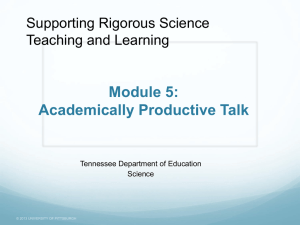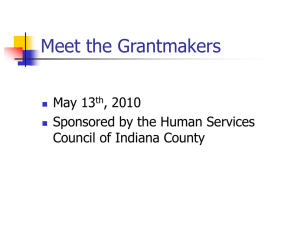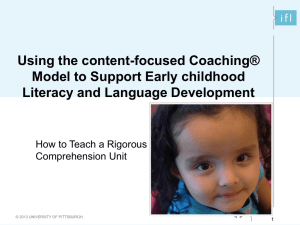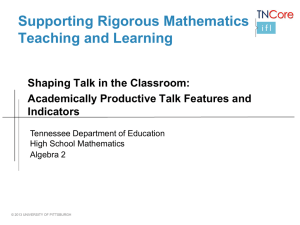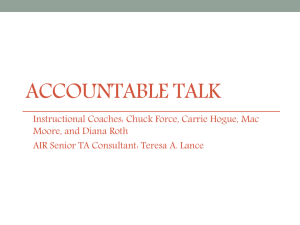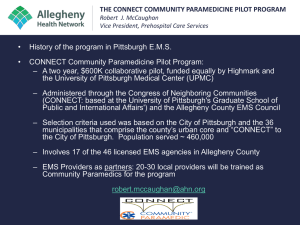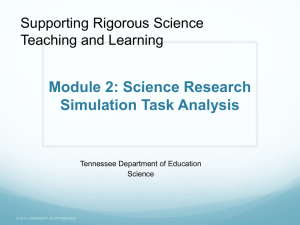Academically Productive Talk in ELA PK
advertisement
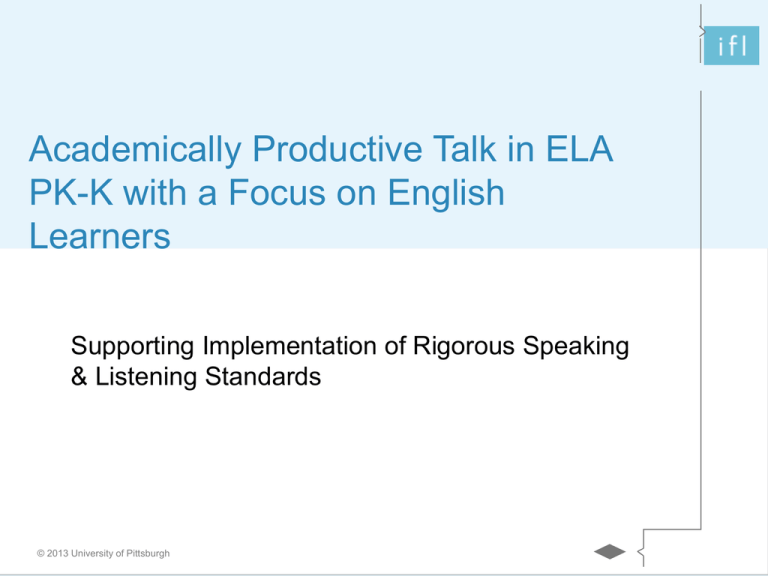
Academically Productive Talk in ELA PK-K with a Focus on English Learners Supporting Implementation of Rigorous Speaking & Listening Standards © 2013 University of Pittsburgh Goal • Deepen understanding of rigorous Speaking and Listening Standards. • Deepen understanding of Accountable Talk® practices in ELA as a way to improve academic rigor of discussions and support students to meet rigorous speaking and listening standards. • Deepen understanding of how Accountable Talk practices in ELA can scaffold the comprehension of English learners and build vocabulary. © 2013 University of Pittsburgh Accountable Talk® is a registered trademark of the University of Pittsburgh. 2 Academically Productive Talk PK-K with a Focus on English Learners What Is It and What Does It Take to Get There? © 2013 University of Pittsburgh 3 Speaking and Listening in Early Childhood •“It has been well established that early childhood is a crucial time for children’s cognitive development. Less understood is that very young children are ready— and excited—to develop skill and understanding in language and literacy, mathematics, and science. •Oral language is arguably the most crucial area of academic focus during the prekindergarten years. Oral language is the primary means by which children gain knowledge about the world, and it is the vital foundation for children’s literacy development. •Research suggests that teachers should encourage parents (of English learners) to continue to speak with and read stories to children in their first language at home. Continued growth in the first language seems to facilitate children’s understanding about the way language works and may help to speed acquisition of new concepts and vocabulary. English learners carry over the learning in the first language to learn in the second language.” •Albert Shanker Institute, 2009 © 2013 University of Pittsburgh 4 Trace Speaking & Listening Standards • Take a moment to review the CCSS Speaking & Listening standards. – What do you notice about the skills and habits that the CCSS values in terms of speaking and listening? • Then study Standard 1: – What do you notice about the progression of Standard 1 (one) from K-2? • What changes? • What remains the same? © 2013 University of Pittsburgh 5 Whole Group Discussion Rigorous Standards for Speaking & Listening – According to the rigorous standards, what do students need to know and be able to do as participants in “structured conversations”? – Why are those habits and skills important for school readiness? – From your experience, how much practice and expertise do English Learners have with being part of structured conversations? © 2013 University of Pittsburgh 6 What are Accountable Talk Practices? • When we say “Accountable Talk practices” or “academically productive talk” we mean to include all varieties of teaching that use classroom discourse strategically, to move students to a higher level of reasoning and communication about their reasoning. • It is talk by teachers and students about academically important content: – Talk that supports development of student reasoning – Talk that supports improvement in students' ability to communicate their thinking – Talk that scaffolds English learners’ comprehension and builds their vocabulary © 2013 University of Pittsburgh 7 Why Focus on Talk and Discourse • Why do educators and researchers in general think that classroom talk has the power to improve both students' learning and ability to reason, and teachers' ability to teach? • Talk can reveal understanding and misunderstanding • Talk supports robust learning by boosting memory in several ways. • Talk supports language development • Talk supports deeper reasoning • Talk supports development of social skills © 2013 University of Pittsburgh 8 Accountable Talk Practices in ELA with a Focus on English Learners © 2012 University of Pittsburgh Text, Task, and Talk 8 © 2013 University of Pittsburgh What We Know From Research About Accountable Talk Practices • It is extremely rare for students to engage in text-based discussions. – Questions most typically asked of students by teachers and textbooks are recitation questions. – Predominant pattern: I-R-E (Initiate-RespondEvaluate). © 2013 University of Pittsburgh 11 Lauren Resnick, Founder IFL LEARNING RESEARCH AND DEVELOPMENT CENTER © 2012 University of Pittsburgh What We Know From Research About Talk In ELA “Accountable talk is talk that is orchestrated by teachers so that students learn to formulate responses to problems, interpretations of text that are correct in disciplinary terms and go beyond what was actually written there.” Lauren Resnick © 2013 University of Pittsburgh 13 An Overview of Accountable Talk Practices • Please take about 10 to 15 minutes to read pages 1-6 of the Introduction to the Accountable Talk Sourcebook (or your notes on the advance reading) for key ideas and to identify one moment that strikes you as most significant to the text. • After you have read, use the two-column note chart to record the moment you select. Write the moment in the left column of your chart. Then, across from it, do a quick write to explain why you consider that moment significant to the text. • Be prepared to share your moment and explanation with a colleague. © 2013 University of Pittsburgh 14 Facilitator’s Model for Significant Moments Significant Moment Explanation of the significance to the text “Accountable Talk practices are not something that springs from students’mouths. It takes time and effort to create an Accountable Talk classroom environment in which this kind of talk is a valued norm. It requires teachers to guide and scaffold student participation” (paragraph 4, p. 1). This moment makes an important point about Accountable Talk practices: namely, that it just doesn’t happen overnight. Changing the nature of talk in the classroom involves a shift in the typical way of doing things—i.e., a shift in culture, in ways of behaving for both teachers and students. Teachers, therefore, must realize their important role in inviting or “norming” students into this culture. This moment is significant because the entire Accountable Talk practices overview is based on the idea of making new demands on both groups. For English Learners this may mean providing opportunities to respond in their first language as needed and providing the scaffolding required for them to be comfortable speaking English. © 2012 University of Pittsburgh 15 Whole Group Discussion • What key ideas did you identify in this overview of Accountable Talk practices? • What moment did you identify as most significant to the text? Why did you consider that moment significant? • What questions do you have? © 2013 University of Pittsburgh 16 Video of an ELA Lesson © 2012 University of Pittsburgh Accountable Talk Features and Indicators • Accountability to the Learning Community (#1) – Students actively participate in classroom talk. – Listen attentively – Elaborate and build on each other’s ideas – Work to clarify or expand a proposition • Accountability to Accurate Knowledge (#2) – Specific and appropriate knowledge – Appropriate evidence for claims and arguments – Commitment to getting it right • Accountability to Rigorous Thinking (#3) – Synthesize several sources of information – Construct explanations and test understanding of concepts – Formulate conjectures and hypotheses – Employ generally accepted standards of reasoning – Challenge the quality of evidence and reasoning © 2013 University of Pittsburgh 18 Engage in Video Task, Part I • Count off by 3s at your table. • Reread the section you are individually responsible for (e.g., accountability to the learning community, accountability to accurate knowledge, accountability to rigorous thinking) to support you in viewing the video. • Individually: • As you watch the tape, look for evidence of the feature of Accountable Talk practices for which you are responsible. • Make notes on the observation page that will help identify for the group specifically where there is evidence for this type of accountability in the tape. © 2013 University of Pittsburgh 19 Accountable Talk Features and Indicators Participant Observation Notes Accountability to the Learning Community(#1) ·Students actively participate in classroom talk ·Listen attentively ·Elaborate and build on each other’s ideas ·Work to clarify or expand a proposition Accountability to Knowledge (#2) ·Specific and appropriate knowledge ·Appropriate evidence for claims and arguments ·Commitment to getting it right Accountability to Rigorous Thinking (#3) ·Synthesize several sources of information ·Construct explanations and test understanding of concepts ·Formulate conjectures and hypotheses ·Employ generally accepted standards of reasoning ·Challenge the quality of evidence and reasoning © 2013 University of Pittsburgh 20 Context of Video Example • Content: Comprehension of a text in an interactive read aloud lesson using the QtA approach • Grade: Kindergarten • Text: Owen • School: New York City Public Schools © 2013 University of Pittsburgh 21 Norms for Collaborative Study – Watching Video Goal of all conversations: To advance our own learning, not “fix” the practice of others • Facilitator chooses lens for study. • Agree to read/watch/talk through the designated lens. • Cite specific examples from text or video. • Build on others’ ideas. • Use language that is respectful of those in the video and in the group. Behave as if those in the video are here in the room with us. © 2013 University of Pittsburgh 22 © 2013 University of Pittsburgh After the Video © 2013 University of Pittsburgh 24 Task Directions, Part I Share Accountable Talk Examples from Video (refer to the transcript as needed) • In trios, discuss: – For each Accountable Talk feature, discuss an example from the video to share with whole group • As a whole group, discuss: – Where in the video did you see evidence of a particular Accountable Talk feature? – How does this Accountable Talk feature support student comprehension? © 2013 University of Pittsburgh 25 Summary Points: Evidence of Accountability to the Community • Many students participate by responding to questions and responding to what another student says • Students listen to one another and are able to agree or disagree with what other students say. • Students respond to other students’ comments and ideas. • Students build directly on what someone else has said or offer a counter opinion. © 2013 University of Pittsburgh 26 Summary Points: Evidence of Accountability to Rigorous Knowledge • Students figure out what the author’s words mean, “handkerchief.” • Students figure out what some of the ideas behind the words mean, “Fuzzy likes what I like.” • Students use paragraphs, not one-word answers, to talk about these ideas. • Students are held accountable to the text. They are frequently asked to back up their answers by asking if that is what the text said. Teacher asks, “Does the text say that?” She rereads so they can figure it out. © 2013 University of Pittsburgh 27 Summary Points: Evidence of Accountability to Rigorous Thinking • Students listen to words and have to figure out what is going on based on abstract language. They are shown the pictures after they talk demonstrate understanding. • Students summarize what they understand, using different words to name the same thing, in an effort to establish understanding even though this was done in a response to a different question. • Students formulate conjecture about what may happen because of actions taken by the characters. • Students challenge the quality of the reasoning when they disagree about a blanket being able to eat food. • Students figure out how the problem was solved in the story. © 2013 University of Pittsburgh 28 Task Directions, Part II • In trios, review the transcript and discuss responses to the following questions. Take notes on your discussion so that you can share your ideas with the whole group. • What is the content or conceptual knowledge being built during this lesson? • How does this kind of Accountable Talk text discussion support student comprehension? • What role did text selection play in supporting this discussion? • What kinds of preparation did teachers engage in to enact this lesson? © 2013 University of Pittsburgh 29 Summary Points: What Is the Content or Conceptual Knowledge Being Built During this Lesson? Students use and elaborate on such concepts and vocabulary including: •giving up a loved object •growing up and moving on •participate in collaborative conversations •understand the meaning of sophisticated words •reading beyond the words in the text •confirm understanding of a text read aloud © 2013 University of Pittsburgh 30 Summary Points: How Does this Kind of Accountable Talk Text Discussion Design Support Student Comprehension of the Text? • Gives students practice engaging in the practices of academic discussions (e.g., citing evidence). • Clarifies misconceptions as they occur to ensure understanding before going on. • Provides students with opportunities to hear, and then use, vocabulary beyond what they can read on their own that they also might use in everyday conversation. • Permits teacher to assess student comprehension at frequent intervals. © 2013 University of Pittsburgh 31 Summary Points: What Role Did Text Selection Play in Supporting This Discussion? • Text was relevant to student interests. • Text was complex because it included challenging concepts/vocabulary that became accessible because of current classroom talk. • Text required students to apply comprehension skills to a challenging text at an instructional level through an interactive read aloud. © 2013 University of Pittsburgh 32 Summary Points: What Preparation is Necessary to Enact Such a Lesson? • Choose a complex text that is appropriate for the students,content standards, the genre. • Determine the central ideas in the text. • Use knowledge of students to determine level of prior knowledge and to anticipate difficulties. • Choose vocabulary to teach. • Identify stopping points to assist comprehension. • Develop open-ended, text-based questions. • Decide what additional graphic support is necessary and when to use it. • Anticipate follow-up responses. © 2013 University of Pittsburgh 33 Task Directions, Part III (refer to the transcript as needed) • In trios, reflect again on the video example you watched to answer the following questions. • What does the teacher do or say to engage the students with the text? • What does the teacher do or say to engage the students with each other during the discussion? • How does this teacher align to the expectations of the listening and speaking standards we studied? What do you notice about how students are building skills and habits that the standards value in terms of speaking and listening? © 2013 University of Pittsburgh 34 Summary Points: What Does the Facilitator Do to Engage Students with the Text? In advance: •Study the text to identify the key ideas to be developed. •Decide where to segment the text to support comprehension of difficult passages requiring inference. •Keep track of key ideas to be developed throughout the discussion. During the discussion: •Pose open-ended and follow-up questions to guide the discussion. •Use specific talk moves to press for accuracy, reasoning, and evidence. •Pay attention to linking and building ideas when necessary. •Press students for evidence. © 2013 University of Pittsburgh 35 Summary Points: What Does the Teacher Do to Engage Students with One Another? • Make sure all students can hear, and ask students to speak up or repeat their comments. • Allow for repetition of important ideas with different words. • Expect students to build on, and not just repeat, what others say. © 2013 University of Pittsburgh 36 Reflect on Academically Productive Talk in ELA • What did you learn and/or what insights did you gain about academically productive talk and supporting implementation of the CCSS Speaking & Listening standards? • What are the implications of your insights for the teaching and learning of all students? • What ideas are you interested in learning more about? Why? © 2013 University of Pittsburgh 37 Bridge to Practice • By ____________________, engage students in a text discussion on a complex text. If possible, audio or video tape your lesson or ask a colleague to transcribe the discussion. Then, reflect in writing on the discussion in terms of its alignment to the speaking and listening standard 1 and your own use of Accountable Talk moves. Draw on specific examples from the discussion to support your ideas. • Be prepared to share your reflection with your colleagues on ______________________________. © 2013 University of Pittsburgh 38
